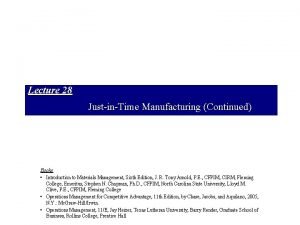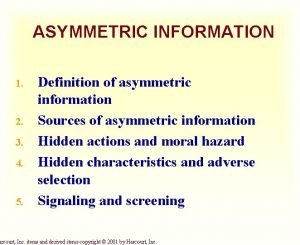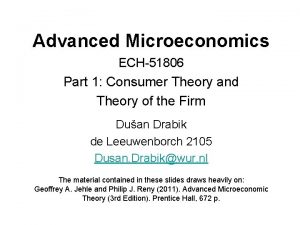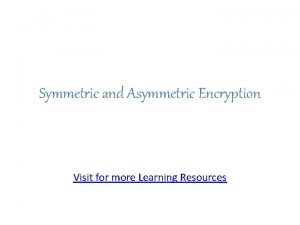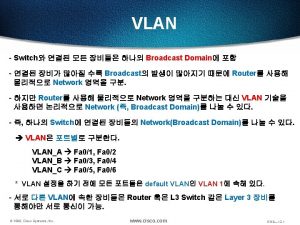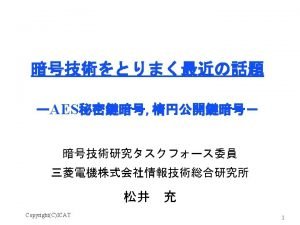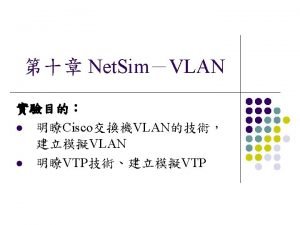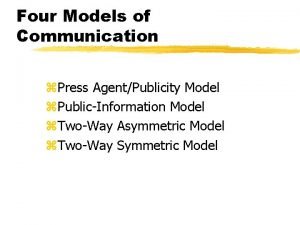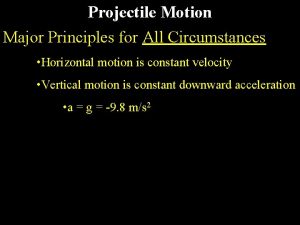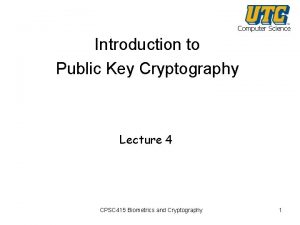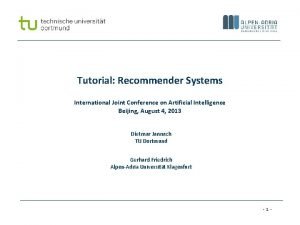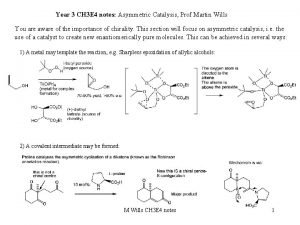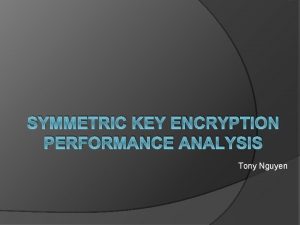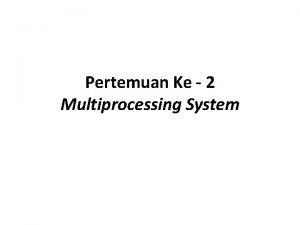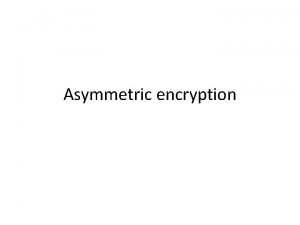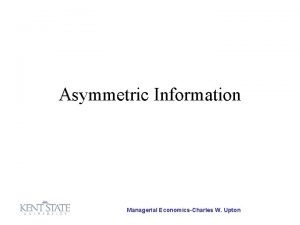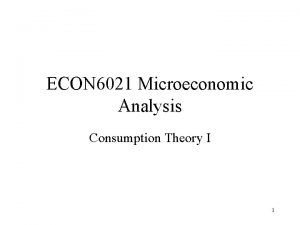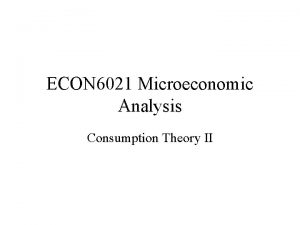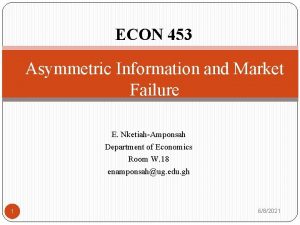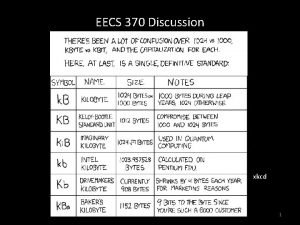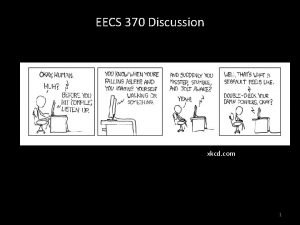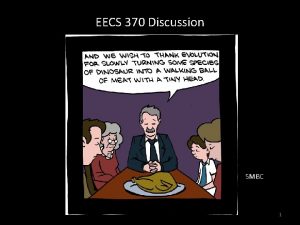Asymmetric Information ECON 370 Microeconomic Theory Summer 2004









































- Slides: 41

Asymmetric Information ECON 370: Microeconomic Theory Summer 2004 – Rice University Stanley Gilbert Econ 370 - Asymmetric Information

Asymmetric Information • Up to now, we have assumed – Everyone is fully informed – Or equally uninformed • In many cases one party has economically relevant information that another party does not have • We term this “Asymmetric Information” • It can produce economic inefficiency Econ 370 - Asymmetric Information 2

Example • Suppose there are two types of umbrellas – Good and Bad • They cannot be distinguished until after they have been used – Bad umbrellas disintegrate after a little use • Umbrellas are valued as follows Value to Consumer Good $14 Bad $8 Econ 370 - Asymmetric Information Cost to Produce $11. 50 $11 3

Example: Full Information Value to Consumer Good $14 Bad $8 Cost to Produce $11. 50 $11 • Under full information, only good umbrellas would be sold • Since the cost to make a bad umbrella exceeds the benefit it provides Econ 370 - Asymmetric Information 4

Example: Asymmetric Information Value to Consumer Good $14 Bad $8 Cost to Produce $11. 50 $11 • If ⅔ umbrellas are good – People are willing to pay: – ⅔(14) + ⅓(8) = $12 per umbrella – Which is greater than the cost to produce them Econ 370 - Asymmetric Information 5

Example: Asymmetric Information Value to Consumer Good $14 Bad $8 Cost to Produce $11. 50 $11 • But firms make more money selling bad umbrellas • If all firms are small, they have incentive to switch to making bad umbrellas • Once ⅔ of firms make bad umbrellas: – People are willing to pay ⅓(14) + ⅔(8) = $10 – Which is less than it costs to make any umbrella Econ 370 - Asymmetric Information 6

Example: Observations • Under full information we have the efficient result – Total Surplus = $14 – 11. 50 = $2. 50 per umbrella • Under Asymmetric information the market collapses – Total surplus = 0 Econ 370 - Asymmetric Information 7

Problems • Adverse Selection – People with a poor hidden characteristic… – take advantage of other’s ignorance – Example: Sick people buying life insurance • Moral Hazard – – People who can take hidden actions… take advantage of other’s ignorance Example: Making poor umbrellas Example: Employees shirking Econ 370 - Asymmetric Information 8

Adverse Selection Example • A company offers Health insurance • Each illness costs $100, 000 • Two types of people: – “Healthy” – “Sick” – Insurance company cannot distinguish them • Types of people differ in probability of getting sick and in willingness to pay for insurance Econ 370 - Asymmetric Information 9

Adverse Selection Type % of Risk of Willingness Cost to Population Illness to Pay Insure Healthy 90% 1/1000 $200 $100 Sick 10% 1/100 $1, 500 $1, 000 • Actuarially Fair insurance charges rates exactly equal to the cost to insure • A Pooling Equilibrium is one in which everyone is charged the same rates, regardless of type Econ 370 - Asymmetric Information 10

Pooling Equilibrium Type % of Risk of Willingness Cost to Population Illness to Pay Insure Healthy 90% 1/1000 $200 $100 Sick 10% 1/100 $1, 500 $1, 000 • If the insurance company pools everybody, it would charge: – 0. 9 × 100 + 0. 1 × 1000 = $190 • Which everyone is willing to pay • So a Pooling Equilibrium exists Econ 370 - Asymmetric Information 11

Example 2 Type % of Risk of Willingness Cost to Population Illness to Pay Insure Healthy 80% 1/1000 $200 $100 Sick 20% 1/100 $1, 500 $1, 000 • If the insurance company pools everybody, it would charge: 0. 8 × 100 + 0. 2 × 1000 = $280 • Which only the sick are willing to pay • So there is NO Pooling Equilibrium exists • The insurance company must charge $1, 000 Econ 370 - Asymmetric Information 12

Observations • Since the company cannot tell “sick” people from “healthy” people • It can only charge a single average rate • Although it would happily insure everyone at fair rates – And people would willing pay those rates • It cannot because it cannot tell people apart • Therefore a majority are uninsured Econ 370 - Asymmetric Information 13

Responses • Some market players lose as a result of asymmetric information • So they have developed strategies to (partially) overcome the problem • Two main strategies – Signalling – Screening Econ 370 - Asymmetric Information 14

Screening • Screening: – is an action taken by the ignorant party – to determine types of people • In general, – It is a cost imposed on the “low-value” party – That the “high-value” parties are unwilling to endure Econ 370 - Asymmetric Information 15

Screening Example Type % of Risk of Willingness Cost to Cost of Population Illness to Pay Insure Physical Healthy 50% 1/1000 $140 $100 $40 Sick 50% 1/500 $250 $200 $150 • Average cost to insure everybody: – 0. 5 × 100 + 0. 5 × 200 = $150 • Which only the sick are willing to pay • Since there is no pooling equilibrium, – the insurance company must charge at least $200 Econ 370 - Asymmetric Information 16

Screening Policies Type % of Risk of Willingness Cost to Cost of Population Illness to Pay Insure Physical Healthy 50% 1/1000 $140 $100 $40 Sick 50% 1/500 $250 $200 $150 • Suppose the insurance company offers two policies – One for $240 with no restrictions – One for $100 but you must pass a physical to get it • Anyone can “pass” the physical – But “sick” people have to bribe the doctor to do it Econ 370 - Asymmetric Information 17

Equilibrium Type % of Risk of Willingness Cost to Cost of Population Illness to Pay Insure Physical Healthy 50% 1/1000 $140 $100 $40 Sick 50% 1/500 $250 $200 $150 • Healthy people – Are unwilling to buy the $240 policy – But will pay the $100 + $40 to get the other policy • Sick – Are willing to buy the $240 policy – Would pay the $100 + $150 for the other policy, – But, it is more expensive than the original policy Econ 370 - Asymmetric Information 18

Screening Observations • The insurance company imposes a requirement – That is more costly for “sick” people to meet • And so is able to separate out “healthy” from “sick” people – And insure everyone • Since no one has an incentive to change – This qualifies as a separating equilibrium • Notice that – Compared to the full-information situation – This is inefficient, due to the cost of the physical Econ 370 - Asymmetric Information 19

Signaling • In several of the example above, – The “low-cost” people stood to gain by being identifiable • While Screening is a cost imposed by the ignorant party to identify types • Signaling is a cost voluntarily adopted by knowledgeable parties to signal their types • Example: Lemon Model Econ 370 - Asymmetric Information 20

Lemon Model • On the used car market • Two types of cars – Good Cars – Lemons • The types are indistinguishable to the buyers • The market has the following characteristics Type % of Value to Population Buyer Seller Good Cars 50% $2, 000 $1, 500 Lemons 50% $1, 000 $500 Econ 370 - Asymmetric Information 21

Pooling Type % of Value to Population Buyer Seller Good Cars 50% $2, 000 $1, 500 Lemons 50% $1, 000 $500 • Since buyers can’t distinguish the cars in advance – They are willing to pay only – 0. 5 × $2000 + 0. 5 × $1000 = $1, 500 • All sellers are willing to participate at that price • So this is a pooling equilibrium Econ 370 - Asymmetric Information 22

Signaling Type % of Value to Population Buyer Seller Good Cars 50% $2, 000 $1, 500 Lemons 50% $1, 000 $500 • Sellers of good cars would like to signal the quality of their cars • Since doing so would enable them to charge $2, 000 • But, it has to be in a way that sellers of lemons are unwilling to emulate Econ 370 - Asymmetric Information 23

Inspecting Lemons Type % of Value to Cost to pass Population Buyer Seller inspection Good Cars 50% $2, 000 $1, 500 $200 Lemons 50% $1, 000 $500 $1, 100 • Sellers can submit their cars for inspection and certification • Profits for owners of good cars with inspection: – 2000 – 200 – 1500 > 1500 – 1500 • So profits from deviating exceed pooling profits • So there is no longer a pooling equilibrium Econ 370 - Asymmetric Information 24

Separating Lemons Type % of Value to Cost to pass Population Buyer Seller inspection Good Cars 50% $2, 000 $1, 500 $200 Lemons 50% $1, 000 $500 $1, 100 • Evaluate the separating equilibrium • Obviously, owners of good cars have no incentive to deviate • Lemon Owners profits from deviating – 2000 – 1100 – 500 < 1000 – 500 • So Lemon owners will not deviate either Econ 370 - Asymmetric Information 25

Observations on Signaling • In our example, owners of good cars have an incentive to deviate from the pooling case – So, the pooling case is not stable – There is no pooling equilibrium when the inspection regime is available • On the other hand, no one has an incentive to deviate from the separating case • The only stable equilibrium here is the separating equilibrium Econ 370 - Asymmetric Information 26

General Comments • Different models of this sort may have different outcomes • All the following are possible – – Pooling equilibrium but no separating equilibrium Separating equilibrium but no pooling equilibrium Both pooling and separating equilibria Neither pooling nor separating equilibria Econ 370 - Asymmetric Information 27

Moral Hazard • Moral Hazard – The knowledgeable party acts differently… – than when everyone possesses full information • Minimizing Moral hazard requires providing incentives to act efficiently • Example – – If I didn’t insure my car, I would install an alarm But since it is insured, I do not Insurance company’s solution: Provide a discount for installing a car alarm Econ 370 - Asymmetric Information 28

Example: Hiring a CEO • Our company, YZA Corporation, is hiring a CEO • Our objective is to maximize profits • The CEO’s objective is to maximize utility • Profits depend on the ‘effort’ the CEO exerts • Effort is costly to the CEO • Let profits be: Π(e) – w – Where ‘e’ represents ‘effort’ • The CEO’s utility is: U = w – f(e) – And can get work elsewhere with utility u. A Econ 370 - Asymmetric Information 29

CEO Roadmap • We will evaluate the following cases: • Full-information equilibrium • Asymmetric information equilibrium – When the CEO is risk-neutral – When the CEO is risk-averse • We seek to identify – The optimal amount of effort the CEO should exert – And an optimal contract to induce that effort Econ 370 - Asymmetric Information 30

Full-Information CEO • The CEO must provide the optimal effort willingly • Thus we have a Participation Constraint – w* – f(e*) ≥ u. A • We have no reason to want to pay more, so set – w* – f(e*) = u. A • Profit maximization means: • Which implies that the optimal e* satisfies: Econ 370 - Asymmetric Information 31

Full-Information Observations • An optimal contract would consist of – w* = u. A + f(e*) if she works e* – Zero otherwise • This is exactly what she would work if she owned the company herself – To see this, write an expression for her utility under those circumstances • Effort does not need to be directly observable – Since profit is a function only of effort, – We can determine how much effort was exerted simply be observing profits Econ 370 - Asymmetric Information 32

Risk-Neutral CEO • Here let profits be Π(e, ε) – w – Where ε is a random variable • Since we cannot observe effort – Pay must take the form: w(Π) • Our Participation Constraint is – E[w(Π(e*, ε))] – f(e*) ≥ u. A • Set E[w(Π(e*, ε))] = u. A + f(e*) • Profits become Econ 370 - Asymmetric Information 33

Risk-Neutral Contract Requirements • An optimal contract would satisfy the Incentive Compatibility Constraint • That is, the Utility maximizing CEO will exert exactly the Profit maximizing effort • That is, mathematically: – E[w(Π(e*, ε))] – f(e*) ≥ E[w(Π(e, ε))] – f(e) Econ 370 - Asymmetric Information 34

Risk-Neutral Contracts • As before, optimal effort is exactly what she would work if she owned the company • One optimal contract (then) is to sell her the company • Another is to allow her to keep any amount above expected profits • Both have the effect of placing all risk on her – (Since she is risk-neutral, that doesn’t bother her) • And ensure she makes the optimal decision Econ 370 - Asymmetric Information 35

Risk-Averse CEO • We greatly simplify our model for this case • Two possible states of the world, ε 1, ε 2 – The states occur with probability p, 1 – p • Two possible effort levels, e 1, e 2 • Profits are Π(e 1, ε 1) = 1 – Otherwise, profits are zero • CEO utility is U = u(w) – f(e) – We let f(e 2) = 0, and f(e 1) = α, and u(0) = 0 – Reservation wage is zero – Wage becomes w 1 if profits are 1, w 0 otherwise Econ 370 - Asymmetric Information 36

Risk-Averse CEO Analysis Assume: e 1 is optimal e 2 is optimal Participation Constraint: E[u(w(Π(e 1, ε)))] – f(e 1) ≥ u. A or pu(w 1) + (1 – p)u(w 0) – α ≥ 0 Participation Constraint: E[u(w(Π(e 2, ε)))] – f(e 2) ≥ u. A or u(w 0) – 0 ≥ 0 or w 0 = 0 Incentive Compatibility: Is satisfied by w 1 = w 0 = 0 E[u(w(Π(e 1, ε)))] – f(e 1) ≥ E[u(w(Π(e 2, ε)))] – f(e 2) pu(w 1) + (1 – p)u(w 0) – α ≥ u(w 0) or p(u(w 1) + u(w 0)) ≥ α Econ 370 - Asymmetric Information 37

Risk-Averse CEO Solution if: e 1 is optimal e 2 is optimal Participation Constraint: pu(w 1) + (1 – p)u(w 0) = α w 1 = w 0 = 0 Incentive Compatibility: p[u(w 1) – u(w 0)] = α Substituting the latter into the former u(w 0) = 0 or w 0 = 0 So Econ 370 - Asymmetric Information 38

Risk-Averse Expected Profits if: e 1 is optimal w 0 = 0 w 1 = u-1(α / p) Expected Profits: E[Π(e 2, ε) – w(Π(e 2, ε))] p(1 – u-1(α / p)) + (1 – p)(0 – 0) e 2 is optimal w 1 = w 0 = 0 Expected Profits: 0– 0=0 Expected Profits = p(1 – u-1(α / p)) Expected Profits = 0 So, e 1 is optimal if 1 ≥ u-1(α / p) Econ 370 - Asymmetric Information 39

Risk-Averse Observations • Since w 1 > α / p – Profits are reduced from the Risk-Neutral case – The firm must reimburse the risk-averse CEO for taking on part of the risk – This amounts to sharing part of the profits with the CEO – Much like Stock Options • If u-1(α / p) > 1 > α / p – Then with a risk-Neutral CEO, the optimal amount of effort is e 1 – While with a risk-averse CEO, the optimal amount of effort is e 2 – In such a case, an inefficient amount of effort is supplied Econ 370 - Asymmetric Information 40

In General • Where both principal (the firm) – And agent (the CEO) are risk-neutral – Then the optimal contract is essentially to sell the firm to the agent • Where the principal is risk-neutral – And agent is risk-averse – Then the optimal contract is to pay a portion of profits as an incentive to the agent – Even still, the result will usually be inefficient Econ 370 - Asymmetric Information 41
 Asymmetric information game theory
Asymmetric information game theory Kanban microeconomic theory
Kanban microeconomic theory Asymmetric information diagram
Asymmetric information diagram Asymmetric information diagram
Asymmetric information diagram Venn diagram
Venn diagram Microeconomic effects of inflation
Microeconomic effects of inflation Microeconomic
Microeconomic Microeconomic
Microeconomic Microeconomic
Microeconomic Game theory econ
Game theory econ Advantages of symmetric encryption
Advantages of symmetric encryption Symmetric and asymmetric matrix
Symmetric and asymmetric matrix Introduction to corporate communication
Introduction to corporate communication Symmetrical growth restriction causes
Symmetrical growth restriction causes Asymmetric vlan
Asymmetric vlan Asymmetric communication
Asymmetric communication Vlan 4094
Vlan 4094 Define ihrm
Define ihrm Aes des
Aes des Ccna vlan
Ccna vlan Asymmetric vlan
Asymmetric vlan Key distribution using asymmetric encryption
Key distribution using asymmetric encryption Asymmetric encryption java
Asymmetric encryption java Two way asymmetrical model example
Two way asymmetrical model example Sunil gupta actor
Sunil gupta actor Verapamil depression side effects
Verapamil depression side effects X=vxt
X=vxt Asymmetric key cryptography
Asymmetric key cryptography Asymmetric synthesis example
Asymmetric synthesis example Asymmetric dominance effect
Asymmetric dominance effect Sharpless asymmetric epoxidation
Sharpless asymmetric epoxidation Symmetric top molecules ppt
Symmetric top molecules ppt Asymmetric key authentication
Asymmetric key authentication Asymmetric synthesis notes
Asymmetric synthesis notes Rsa vs aes performance
Rsa vs aes performance Tuliskan tugas program slave
Tuliskan tugas program slave Asymmetric vlan
Asymmetric vlan Asymmetric multicore processing
Asymmetric multicore processing Asymmetric bandwidth
Asymmetric bandwidth Eecs 496
Eecs 496 Slidetodoc.com
Slidetodoc.com Ese 370
Ese 370

